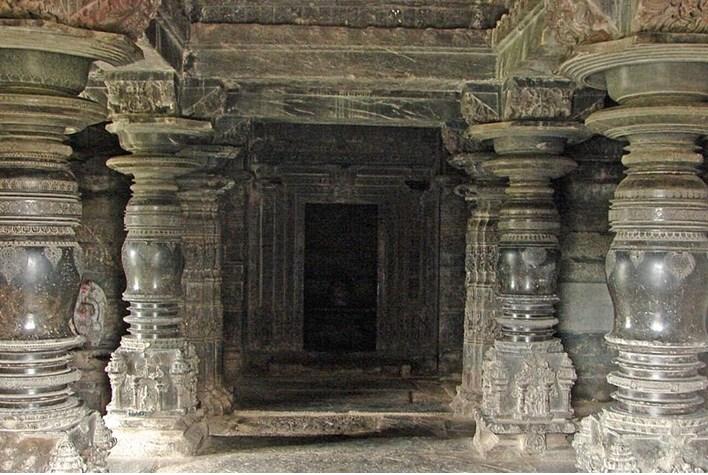
1.)Mehandipur Balaji Temple,
Rajasthan:
In Dausa district of Rajasthan, thousands of devotees turn up at Mahendipur Balaji Temple to rid themselves of ghosts, demons and other evil spirits every day. Offering penance in extreme ways, pouring boiling water on oneself , hanging from the ceiling, chaining themselves to walls, and banging their heads against the walls is said to rid a person of all things evil.
No Prasad is offered at this temple, and it is said that once you leave the temple, you must not turn back to look at it; who knows, evil spirits might take that as an invitation to inhabit your body.
STORY BEHIND MEHANDIPUR BALAJI TEMPLE
The temple is dedicated to the hindu god lord Hanuman. Balaji is a childhood name of lord Hanuman.
Earlier this area was a thick dense forest where ancestors of Shri Mahantji starts worship of Balaji. The story behind the Shri Balaji temple explained that ancestors of Shri Mahant ji saw the three deities in the dreams with a magnificent temple. He also heard a voice which was ordering him to ready for serving his duty. All of a sudden Lord Shri Balaji appeared before him and ordered "Take duty of serving me".
After that incident ancestors started worshipping by performing puja and aarti regularly. Once upon a time some miscreants tried to dig out the deity but they could not reach the bottom of the statue as it is the part of the hill " Kanak Bhoodharakar Shareera".
It is also known that the water pot in the feet of the deity never dried up due to continuous flow of water from left side of chest of statue of lord Shri Balaji.
Rajasthan:
In Dausa district of Rajasthan, thousands of devotees turn up at Mahendipur Balaji Temple to rid themselves of ghosts, demons and other evil spirits every day. Offering penance in extreme ways, pouring boiling water on oneself , hanging from the ceiling, chaining themselves to walls, and banging their heads against the walls is said to rid a person of all things evil.
No Prasad is offered at this temple, and it is said that once you leave the temple, you must not turn back to look at it; who knows, evil spirits might take that as an invitation to inhabit your body.
STORY BEHIND MEHANDIPUR BALAJI TEMPLE
The temple is dedicated to the hindu god lord Hanuman. Balaji is a childhood name of lord Hanuman.
Earlier this area was a thick dense forest where ancestors of Shri Mahantji starts worship of Balaji. The story behind the Shri Balaji temple explained that ancestors of Shri Mahant ji saw the three deities in the dreams with a magnificent temple. He also heard a voice which was ordering him to ready for serving his duty. All of a sudden Lord Shri Balaji appeared before him and ordered "Take duty of serving me".
After that incident ancestors started worshipping by performing puja and aarti regularly. Once upon a time some miscreants tried to dig out the deity but they could not reach the bottom of the statue as it is the part of the hill " Kanak Bhoodharakar Shareera".
It is also known that the water pot in the feet of the deity never dried up due to continuous flow of water from left side of chest of statue of lord Shri Balaji.
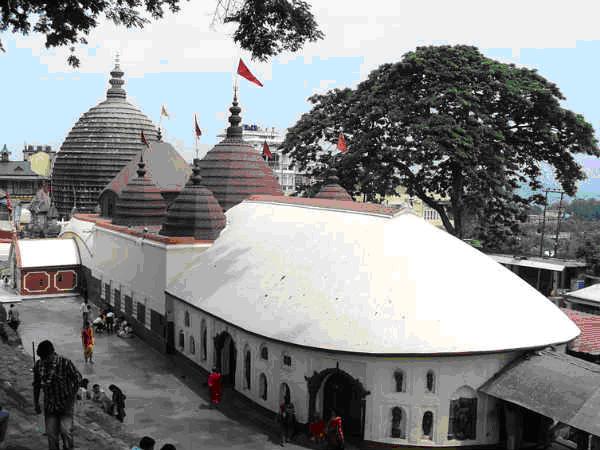
2. Kamakhya Devi Temple,
Assam:
Perched atop the Nilachal Hill in Guwahati, Assam resides the Maa Kamakhya Devi Temple, one of the most famous temples in India. It is one of the oldest of the 51 Shakti Peethas in the Indian subcontinent. The temple does not have a sculpture to worship, however, what it does have is the yoni or vagina of Devi Sati, the wife of Lord Shiva, covered with a red silk sari.
Every year during monsoon, the goddess menstruates, and the temple is closed down for three days. It is also when the Tantric fertility festival or Ambubachi Mela is celebrated here, till the fourth day when the temple reopens. It is also said that the underground spring that flows in the sanctum of the temple turns red on these three days. Devotees are offered a piece of the red cloth used to cover the stone yoni during the days of menstruation as ‘prasad’.
Note:- The main temple is situated in a temple complex comprising of individual temples, dedicated to the ten mahavidyas – Kali, Tara, Sodashi, Bhuvaneshwari, Bhairavi, Chinnamasta, Dhumavati, Bagalamukhi, Matangi and Kamala. Among these Tripurarisundari , Matangi and Kamala reside inside the main temple, whereas the other seven reside in individual temples
STORY BEHIND KAMAKHAYA DEVI TEMPLE :-
It is one of the 51 Shakti peeths.
Once Sati fought with her husband Shiva to attend her father's great yagna. Despite her husband lord shiva’s disapproval sati had gone to attend the universal yajna organized by her father ‘Dakha’. At the grand yagna, Sati's father Daksha insulted her husband. Sati was angered and in her shame, she jumped into the fire and killed herself.
When Shiva came to know that his beloved wife had committed suicide, he went insane with rage. He placed Sati's dead body on his shoulders and did the tandav or dance of destruction.
To calm him down, Vishnu cut the dead body with his chakra. The 51 places where Sati's body parts fell are called Shakti peeths. Kamakhya temple is special because Sati's womb and vagina fell here.
History of the Name 'Kamakhya':
The God of love, Kamadeva had lost his virility due to a curse. He sought out the Shakti's womb and genitals and was freed from the curse. This is where 'love' gained his potency and thus, the deity 'Kamakhya' devi was installed and worshipped here. Some people also believe that the Kamakhya temple is a place where Shiva and devi Sati had their romantic encounters. As the Sanskrit word for lovemaking is 'kama', the place was named Kamakhya.
Assam:
Perched atop the Nilachal Hill in Guwahati, Assam resides the Maa Kamakhya Devi Temple, one of the most famous temples in India. It is one of the oldest of the 51 Shakti Peethas in the Indian subcontinent. The temple does not have a sculpture to worship, however, what it does have is the yoni or vagina of Devi Sati, the wife of Lord Shiva, covered with a red silk sari.
Every year during monsoon, the goddess menstruates, and the temple is closed down for three days. It is also when the Tantric fertility festival or Ambubachi Mela is celebrated here, till the fourth day when the temple reopens. It is also said that the underground spring that flows in the sanctum of the temple turns red on these three days. Devotees are offered a piece of the red cloth used to cover the stone yoni during the days of menstruation as ‘prasad’.
Note:- The main temple is situated in a temple complex comprising of individual temples, dedicated to the ten mahavidyas – Kali, Tara, Sodashi, Bhuvaneshwari, Bhairavi, Chinnamasta, Dhumavati, Bagalamukhi, Matangi and Kamala. Among these Tripurarisundari , Matangi and Kamala reside inside the main temple, whereas the other seven reside in individual temples
STORY BEHIND KAMAKHAYA DEVI TEMPLE :-
It is one of the 51 Shakti peeths.
Once Sati fought with her husband Shiva to attend her father's great yagna. Despite her husband lord shiva’s disapproval sati had gone to attend the universal yajna organized by her father ‘Dakha’. At the grand yagna, Sati's father Daksha insulted her husband. Sati was angered and in her shame, she jumped into the fire and killed herself.
When Shiva came to know that his beloved wife had committed suicide, he went insane with rage. He placed Sati's dead body on his shoulders and did the tandav or dance of destruction.
To calm him down, Vishnu cut the dead body with his chakra. The 51 places where Sati's body parts fell are called Shakti peeths. Kamakhya temple is special because Sati's womb and vagina fell here.
History of the Name 'Kamakhya':
The God of love, Kamadeva had lost his virility due to a curse. He sought out the Shakti's womb and genitals and was freed from the curse. This is where 'love' gained his potency and thus, the deity 'Kamakhya' devi was installed and worshipped here. Some people also believe that the Kamakhya temple is a place where Shiva and devi Sati had their romantic encounters. As the Sanskrit word for lovemaking is 'kama', the place was named Kamakhya.
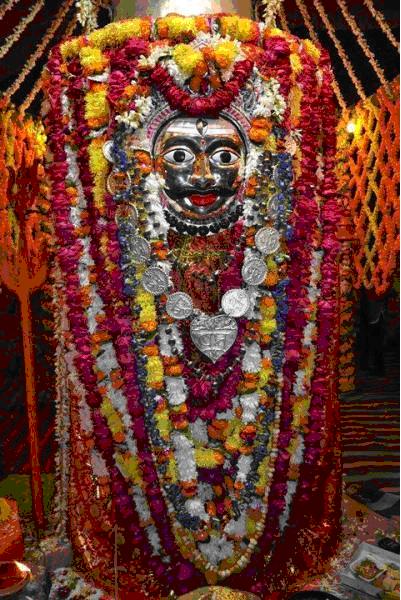
3)Kalbhairav Nath Temple of Varanasi
In the holy city of Varanasi, is the abode of lord Kal Bhairav Nath, a reincarnation of lord Shiva. Believe it or not, the only offerings that are made to god here is alcohol, be it whiskey or wine. Alcohol is poured directly into the diety’s open mouth and the same is offered to devotees as Prasad.
Unlike other shops outside temples that sell flowers and sweets as an offering, the stalls outside this temple offer only alcohol for sale.
Story behind Kalbhairav Nath Temple
This temple is dedicated lord kal bhairav is believed to be the “Kotwal of Sati pind”. Without his permission no one can even touch to the Sati Pind. Also, no one can able to stay in Varanasi
The origin of Bhairava can be traced to the conversation between Brahma and Vishnu recounted in the Shiv Mahapuran where Vishnu asked Brahma who is the supreme creator of the Universe. Arrogantly, Brahma told Vishnu to worship him, he being the supreme creator. One day Brahma thought, "I have five heads, Shiva also has five heads. I can do everything that Shiva does and therefore I am Shiva" Brahma had become a little egoistic. Not only had he became egoistic, he started to forge the work of Shiva. Brahma started interfering in what Shiva was supposed to do. Then Mahadeva (Shiva) threw a small nail from His finger, which assumed the form of Kala Bhairava, and casually went to cut the head of Brahma. The skull of Brahma is held in the hands of Kala Bhairava; Brahma Kapala in the hands of Kala Bhairava and Brahma’s ego was destroyed and he became enlightened. Then onwards he became useful to himself and to the world and deeply grateful to Shiva. In the form of the Kaala Bhairava, Shiva is said to be guarding each of these Shaktipeeths. Each Shaktipeeth temple is accompanied by a temple dedicated to Bhairava

4)Stambheshwar Mahadev, Gujarat
Located close to Vadodra in Gujarat , the Stambheshwar mahadev temple shares shores with the Arabian sea, lord shiva resides here, and blesses those who dare to venture into it. It is one of thje most famous temples in India.
The only weird thing about this temple is that it can be visited onl;y during hours of low tide .In hours of high tide the temple is swallowed up completely by the sea and it reappears hours latyer when the water descends.
STORY BEHIND STAMBHESHWAR MAHADEV TEMPLE
Legends Say that this temple was build by Kartikeya ( called Murugan in Tamil) after he killed Tarkasura. He built the temple at the same spot where he killed tarkasura.
While the deities hailed the glory of Kartikeya for having killed Tarakasur, Kartikeya himself was saddened by his act. He told the deities--'I regret for having killed Tarakasur because he was a great devotee of Lord Shiva. Is there any way to atone for my sin?'Lord Vishnu consoled him---'Killing a wicked person, who nourishes himself on the blood of innocent people, is not a sinful deed. But, still, if you feel guilty then there is no better way to atone for your sin than worshipping Lord Shiva. Install Shivalingas and worship them with deep devotion.'
Kartikeya instructed Vishnukarma to make three divine Shivalingas. Later on Kartikeya installed these Shivalingas at three different places and worshipped them with appropriate rituals. In course of time these three holy places came to be known as Pratigyeshwar, Kapaleshwar and Kumareshwar.
Kartikeya, while worshipping at Kapaleshwar sprinkled holy water on the Shivalinga and prayed so that Tarakasur's soul rested in peace. He also offered sesame seeds to Lord Kapaleshwar and prayed --'May my offerings made in the form of sesame seeds reach Tarak--the descendant of Sage Kashyap.' This way, Kartikeya was absolved of his sins.
5) BATUK BHAIRAV TEMPLE - VARANASI – Lord bhairav is a fierce incarnation of Lord Shiva. The Bal Rup(cradle) of lord Kala Bhairav is known as Batuk Bhairav. He was born from the third eye of lord Shiva & he is a symbol or his anger.
Batuk Bhairav is a small form of Bhairavnath which is one of the incarnations of Lord Shiva. The temple in Kashi has many miracles in store for everyone of us from hundreds of year it’s the same, nothing has changed. In this temple there is a akhand deep (lamp which burns forever) & is believed to have magical powers of lord Bhairav. There are many dogs near the temple which are waahans(transport) of lord Bhairav. Interesting thing here is that these dogs during the time of Aarti produce voice which is similar to shankh and also these dogs don’t harm anyone.
The oil of the Akhand deep is miraculous for many people. Those who have some disease, it helps to cure the disease and wounds. Stange thing is that this oil act as a medicine for dog bites. Several people come here daily to fulfill their wishes. It’s said that in kalayuga lord Bhairav is the god which listens to the prayers of his devotees quickly compared to any other god.
STORY BEHIND BATUK BHAIRAV TEMPLE
The origin of Bhairav can be traced to the conversation between Lord Brahma and Lord Vishnu recounted in “Shiv Maha-Puran” where Lord Vishnu asks Lord Brahma who is the supreme creator of the Universe. Arrogantly, Brahma tells Vishnu to worship him because he (Brahma) is the supreme creator. This angered Shiva who then incarnated in the form of Bhairava to punish Brahma.
Bhairava beheaded one of Brahma’s five heads and since then Brahma has only four heads. When depicted as Kala Bhairava, Bhairava is shown carrying the decapitated head of Brahma. Cutting off Brahma’s fifth head made him guilty of the crime of killing, and as a result, he was forced to carry around the head for years and roam as Bhikshatana, a mendicant, until he had been absolved of the sin.
In the form of the frightful Bhairava, Shiva is said to be guarding each of these Shaktipeeths. Each Shaktipeeth temple is accompanied by a temple dedicated to Bhairava.
Batuk Bhairav is a small form of Bhairavnath which is one of the incarnations of Lord Shiva. The temple in Kashi has many miracles in store for everyone of us from hundreds of year it’s the same, nothing has changed. In this temple there is a akhand deep (lamp which burns forever) & is believed to have magical powers of lord Bhairav. There are many dogs near the temple which are waahans(transport) of lord Bhairav. Interesting thing here is that these dogs during the time of Aarti produce voice which is similar to shankh and also these dogs don’t harm anyone.
The oil of the Akhand deep is miraculous for many people. Those who have some disease, it helps to cure the disease and wounds. Stange thing is that this oil act as a medicine for dog bites. Several people come here daily to fulfill their wishes. It’s said that in kalayuga lord Bhairav is the god which listens to the prayers of his devotees quickly compared to any other god.
STORY BEHIND BATUK BHAIRAV TEMPLE
The origin of Bhairav can be traced to the conversation between Lord Brahma and Lord Vishnu recounted in “Shiv Maha-Puran” where Lord Vishnu asks Lord Brahma who is the supreme creator of the Universe. Arrogantly, Brahma tells Vishnu to worship him because he (Brahma) is the supreme creator. This angered Shiva who then incarnated in the form of Bhairava to punish Brahma.
Bhairava beheaded one of Brahma’s five heads and since then Brahma has only four heads. When depicted as Kala Bhairava, Bhairava is shown carrying the decapitated head of Brahma. Cutting off Brahma’s fifth head made him guilty of the crime of killing, and as a result, he was forced to carry around the head for years and roam as Bhikshatana, a mendicant, until he had been absolved of the sin.
In the form of the frightful Bhairava, Shiva is said to be guarding each of these Shaktipeeths. Each Shaktipeeth temple is accompanied by a temple dedicated to Bhairava.
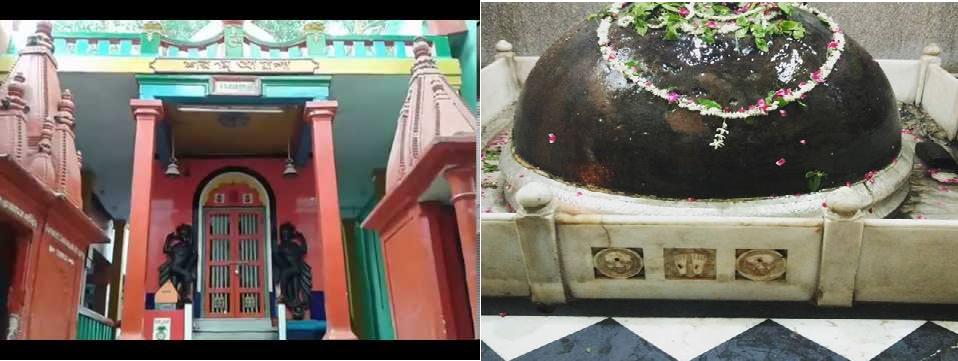
6) Shri Tilbhandeshwar Mahadev Temple - Varanasi
It is believed that the Shiv Ling in this temple emerged by itself and increases every year by the size of a "til" ( Sesame Seed). Presently the Shiv Ling is 3.5 feet in height and the diameter of the base is approximately 3 feet. This temple is one of the oldest and most famopus temple in the holy city of Varanasi. This temple is believed to be constructed in 18th century. The temple is dedicated to Lord Shiva and is situated in Pandey Haveli, next to Bengali Tola Inter College (Bhelupur, Varanasi)
STORY BEHIND TILBHANDESHWAR MAHADEV MANDIR
Like many other temples of the worlds’ oldest living city of Varanasi the temple has surfaced itself some 2500 years ago and hence called Swyambhu, translates to appeared itself.
Shri Tilbhandeshwar Mahadev Mandir was constructed in 18th century
It is considered that Mata Sharda had spent some days in the Varanasi at this temple.
It is believed that the Shiv Ling in this temple emerged by itself and increases every year by the size of a "til" ( Sesame Seed). Presently the Shiv Ling is 3.5 feet in height and the diameter of the base is approximately 3 feet. This temple is one of the oldest and most famopus temple in the holy city of Varanasi. This temple is believed to be constructed in 18th century. The temple is dedicated to Lord Shiva and is situated in Pandey Haveli, next to Bengali Tola Inter College (Bhelupur, Varanasi)
STORY BEHIND TILBHANDESHWAR MAHADEV MANDIR
Like many other temples of the worlds’ oldest living city of Varanasi the temple has surfaced itself some 2500 years ago and hence called Swyambhu, translates to appeared itself.
Shri Tilbhandeshwar Mahadev Mandir was constructed in 18th century
It is considered that Mata Sharda had spent some days in the Varanasi at this temple.
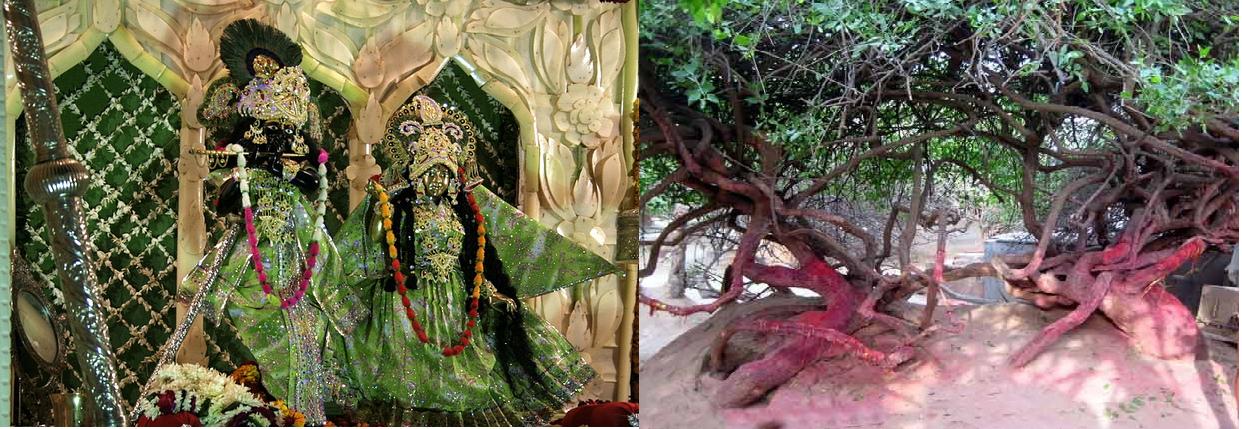
7)NIDHIVAN - Vrindavan
This temple is counted among one of the most mysterious temples of India. Nidhivan is a forest with the holy temple Rang Mahal located in the temple city of India – Vrindavan. The temple is dedicated to deity Radha-krishna.
Apart from holding several mythological beliefs, the activities that take place in and around the temple are beyond explanation. Nidhivan is a dense forest with lush green trees. The interesting thing is that the barks of the trees are hollow & the land is absolutely dry, but the trees remain loaded with green leaves throughout the year. No tree stands straight & is bent towards the earth. Devotees believe that the trees convert to gopis and perform rasleela at night.
Coming to Rang Mahal There is a deity of lord Radha-Krishna decorated beautifully. The temple is shut after the evening prayer & various things such as saree, sweets, beetel nuts are kept inside the temple. Every morning the priests see that the sweets are partially eaten and the clothes have been used. No one is allowed on the premises of the temple after sunset. It is believed that Radhe-krishna comes to the temple every night for rest. Anyone who has tried to see what happens in the night either dies or goes blind or becomes insane. The place remains mysterious till date.
STORY BEHIND NIDHIVAN
It is believed that after sunset Shri Krishna himself comes here and performs ‘Maha-Raasleela’. Many locals have claimed to have heard the sound of ‘ ghungroos’ at night .
It is said that all the trees around the area light up at night to welcome the gods.
It is believed that after Raas-leela, shree Krishna & Radha Rani comes to the temple for rest. This is ‘Gods Own Abode’ in one of the holiest town of the country.
The temple derives its name from ‘Nidhi’ meaning Treasure and ‘Van’ meaning forest. The land around the temple is really dry – still the trees remain green all throughout the year, it is said that these trees are in fact ‘Gopis’. After nightfall they perform ‘Maha-Raasleela’ with shri Krishna & Radha Rani.
Those with wholesome devotion feel something amazing & attractive in this place. There is also a small well inside the area. It is believed that once while performing Raas Leela Radha Rani became thirsty & Krishna built a well with his flute and quenched her thirst. It is said that it is the love and devotion of the people of vrindavan that forces lord Krishna to come there every night.
Many historians and scientists in a bid to unlock the mystery have visited this place but came back convinced that this place really houses the lord.
Another Story
There is another story of the rock found in the garden. Once a young Krishna and his friends were playing hide and seek in forest & the lord hid behind the mountain. Another story has it that by hearing the sweet sound of shree Krishna’s flute, the huge mountain got melted into a rock piece. In present day, footprints of Bal Krishna and his calf can be seen on the mountain.
8.Kasivisvesvara Temple, Lakkundi - Karnataka
The uniqueness of this temple is that the shrines of lord Shiva and Sun God
are facing each other. In addition to that, the Sun god is facing west instead of facing east. This is the only temple where the Sun god faces West.
Story Behind Kasivisvesvara Temple
Also spelt Kashivishveshvara and sometimes called Kashivishvanatha
According to Henry Cousens, it is one of the most ornate temples in the Kannada spoken region of India. The Kasivisvesvara Temple epitomizes the shift in Chalukyan artistic achievements, toward sharper and crisper stone work not seen in earlier constructions, taking full advantage of the effect of light and shade. Special attention was paid to moldings, arches and other details on the tower, and decorations on door jambs and lintels.
This temple is counted among one of the most mysterious temples of India. Nidhivan is a forest with the holy temple Rang Mahal located in the temple city of India – Vrindavan. The temple is dedicated to deity Radha-krishna.
Apart from holding several mythological beliefs, the activities that take place in and around the temple are beyond explanation. Nidhivan is a dense forest with lush green trees. The interesting thing is that the barks of the trees are hollow & the land is absolutely dry, but the trees remain loaded with green leaves throughout the year. No tree stands straight & is bent towards the earth. Devotees believe that the trees convert to gopis and perform rasleela at night.
Coming to Rang Mahal There is a deity of lord Radha-Krishna decorated beautifully. The temple is shut after the evening prayer & various things such as saree, sweets, beetel nuts are kept inside the temple. Every morning the priests see that the sweets are partially eaten and the clothes have been used. No one is allowed on the premises of the temple after sunset. It is believed that Radhe-krishna comes to the temple every night for rest. Anyone who has tried to see what happens in the night either dies or goes blind or becomes insane. The place remains mysterious till date.
STORY BEHIND NIDHIVAN
It is believed that after sunset Shri Krishna himself comes here and performs ‘Maha-Raasleela’. Many locals have claimed to have heard the sound of ‘ ghungroos’ at night .
It is said that all the trees around the area light up at night to welcome the gods.
It is believed that after Raas-leela, shree Krishna & Radha Rani comes to the temple for rest. This is ‘Gods Own Abode’ in one of the holiest town of the country.
The temple derives its name from ‘Nidhi’ meaning Treasure and ‘Van’ meaning forest. The land around the temple is really dry – still the trees remain green all throughout the year, it is said that these trees are in fact ‘Gopis’. After nightfall they perform ‘Maha-Raasleela’ with shri Krishna & Radha Rani.
Those with wholesome devotion feel something amazing & attractive in this place. There is also a small well inside the area. It is believed that once while performing Raas Leela Radha Rani became thirsty & Krishna built a well with his flute and quenched her thirst. It is said that it is the love and devotion of the people of vrindavan that forces lord Krishna to come there every night.
Many historians and scientists in a bid to unlock the mystery have visited this place but came back convinced that this place really houses the lord.
Another Story
There is another story of the rock found in the garden. Once a young Krishna and his friends were playing hide and seek in forest & the lord hid behind the mountain. Another story has it that by hearing the sweet sound of shree Krishna’s flute, the huge mountain got melted into a rock piece. In present day, footprints of Bal Krishna and his calf can be seen on the mountain.
8.Kasivisvesvara Temple, Lakkundi - Karnataka
The uniqueness of this temple is that the shrines of lord Shiva and Sun God
are facing each other. In addition to that, the Sun god is facing west instead of facing east. This is the only temple where the Sun god faces West.
Story Behind Kasivisvesvara Temple
Also spelt Kashivishveshvara and sometimes called Kashivishvanatha
According to Henry Cousens, it is one of the most ornate temples in the Kannada spoken region of India. The Kasivisvesvara Temple epitomizes the shift in Chalukyan artistic achievements, toward sharper and crisper stone work not seen in earlier constructions, taking full advantage of the effect of light and shade. Special attention was paid to moldings, arches and other details on the tower, and decorations on door jambs and lintels.
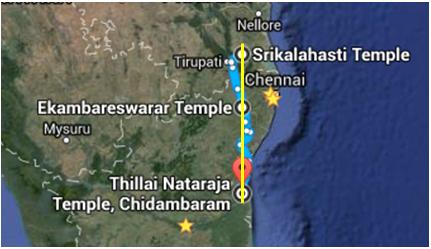
9.Linearity of Chidambaram Nataraja temple Kanchipuram Ekambareswar
and Sri Kalahasti temple
Some mysterious temples have left people in awe. In the era where there were no scientific tools, three temples were built in the exact same longitudes at 79deg 42 min East. The Chidambaram Nataraja temple in Tamil Nadu, Kanchipuram Ekambareswar temple in kanchipuram district of Tamil Nadu and Sri Kalahasti temple in Andhra Pradesh all lie in a straight line.
Story behind these Temples
These are 3 out of the 5 temples that are clubbed together and called as Pancha boota Stalam
These temples are considered to be shiva lingam representing various elements of earth such as air, Earth & Space. The temple for air is in Kalahasti , earth is in Kanchipuram and The temple for space/sky is in Chidambara. A flickering lamp in the SriKalahasti temple shows the play of wind, the swayambhu lingam of sand at Kanchipuram signifies the deitie’s association with the earth while the formless space at Chidambaram shows the association of the Supreme being with formlessness or nothingness.
All 3 temples are constructed at least 1000 years ago. No satellite technology was available at that time but very accurate placements. Truly an engineering, astrological and geographical wonder.
The fact that there were no scientific tools to measure the points on earth leaves many people in dismay. Some consider it to be a co-incidence, but even if it’s a co-incidence it is worth noticing.
10)VEERABHADRA TEMPLE - The mystery of hanging Pillars
Veerbhadra Temple is located in the Lepakshi district of of Andhra Pradesh. At times it is also known as Lepakshi temple, The temple is known for its architectural beauty but what catches hold of most of the visitors is the hanging pillars of the temple . Although there are 70 pillars in the temple but one pillar which lies hanging in the premises of the temple is the piece of wonder. To prove that many people pass a piece of cloth through the bottom of the pillar.
Story Related to Veerabhadra Temple – According to puranas this temple was built by the Sage ‘Agastya’ . It has idols of Ganesh, Nandi, Veerabhadra, Shiva Bhadrakali , Vishnu and Lakshmi.
Another legend gives the town a significant place in the ‘Puranas’ . According to Ramayana, this was the place where the bird Jatayu fell wounded after a futile battle against Ravana who was carrying away Sita. When Shri Ram reached the spot, he saw the bird and said compassionately “ Le – Pakshi ” – Rise bird in Telugu.
and Sri Kalahasti temple
Some mysterious temples have left people in awe. In the era where there were no scientific tools, three temples were built in the exact same longitudes at 79deg 42 min East. The Chidambaram Nataraja temple in Tamil Nadu, Kanchipuram Ekambareswar temple in kanchipuram district of Tamil Nadu and Sri Kalahasti temple in Andhra Pradesh all lie in a straight line.
Story behind these Temples
These are 3 out of the 5 temples that are clubbed together and called as Pancha boota Stalam
These temples are considered to be shiva lingam representing various elements of earth such as air, Earth & Space. The temple for air is in Kalahasti , earth is in Kanchipuram and The temple for space/sky is in Chidambara. A flickering lamp in the SriKalahasti temple shows the play of wind, the swayambhu lingam of sand at Kanchipuram signifies the deitie’s association with the earth while the formless space at Chidambaram shows the association of the Supreme being with formlessness or nothingness.
All 3 temples are constructed at least 1000 years ago. No satellite technology was available at that time but very accurate placements. Truly an engineering, astrological and geographical wonder.
The fact that there were no scientific tools to measure the points on earth leaves many people in dismay. Some consider it to be a co-incidence, but even if it’s a co-incidence it is worth noticing.
10)VEERABHADRA TEMPLE - The mystery of hanging Pillars
Veerbhadra Temple is located in the Lepakshi district of of Andhra Pradesh. At times it is also known as Lepakshi temple, The temple is known for its architectural beauty but what catches hold of most of the visitors is the hanging pillars of the temple . Although there are 70 pillars in the temple but one pillar which lies hanging in the premises of the temple is the piece of wonder. To prove that many people pass a piece of cloth through the bottom of the pillar.
Story Related to Veerabhadra Temple – According to puranas this temple was built by the Sage ‘Agastya’ . It has idols of Ganesh, Nandi, Veerabhadra, Shiva Bhadrakali , Vishnu and Lakshmi.
Another legend gives the town a significant place in the ‘Puranas’ . According to Ramayana, this was the place where the bird Jatayu fell wounded after a futile battle against Ravana who was carrying away Sita. When Shri Ram reached the spot, he saw the bird and said compassionately “ Le – Pakshi ” – Rise bird in Telugu.

